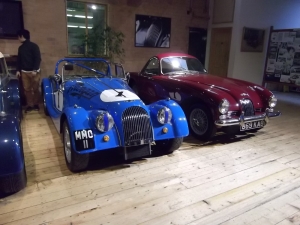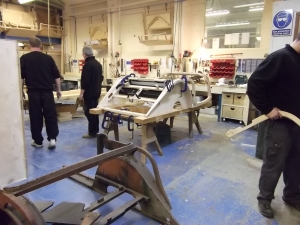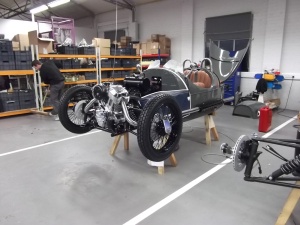This post began as something to write about during a blogging workshop which was held at Coventry University a week or so ago under the auspices of the Guild of Motoring Writers (GoMW) and co-hosted by Automotive Journalism lecturer Andrew Noakes and GoMW Breakthrough Blogger of the Year Keith Jones. However, as it was about a rather special automotive experience, I thought I’d better give it a polish and post it.
Just under eighteen months ago, I was afforded the opportunity to do something that anyone with a fluid ounce (or is that millilitres these days?) of petrol in their veins should do: along with a cohort of automotive design and journalism students from Coventry University, I popped down to Great Malvern in Worcestershire and visited the Morgan car factory.
Actually, you don’t need intravenous petroleum to appreciate Morgan – you can visit out of a sense of history, or of culture, or an appreciation for craftsmanship and style. Indeed, as you pass the factory on Pickersleigh Avenue, you somehow sense that Morgan isn’t a typical 21st century car maker, and the tour doesn’t disappoint as you are taken into a world of craft automotive manufacture, with a little high-technology thrown in.
Split into two groups from the outset, my particular group did the tour backwards – sort of – beginning in the despatch shop where customers’ cars are lined up for delivery, before going to see where the bodywork is fitted and engines are installed. Our next port of call was the body frame workshop, which is a particular delight as your senses are first assailed by the smell of wood and sawdust. And then you see – some sat upon trestles, some resting on the floor – the legendary ash frames, the architecture that will become a 4/4, a Plus-4 or a Roadster, and you begin to ‘feel’ the essence of Morgan (incidentally, contrary to popular belief, it is the body frame – and not the chassis – of a Morgan that is made of wood). It was in this workshop that we were all given wood, in the shape of an offcut with which we were presented as a souvenir by our guide. Anywhere else, and such an offcut would just be an odd-shaped bit of wood; but this is Great Malvern and so it was much, much more than a piece of misshaped arboreal detritus. I still have it.
Then it was over to the trimming shop where seats are fitted and dashboards installed, before proceeding to the facility where final checks are made – we didn’t get to see the paint shop – and then heading to another building where the neo-iconic 3-Wheelers are made. We only saw the final stage of this, but it was enough for a few pictures and a ponder over my next lottery win. I’ll probably need more than a tenner though.
Cars are more than just machines, and Morgans are more than just cars. They are innately anthropocentric. Whether it is the bespoke customer specifications or even just their hand-made nature, there is so much in the cars that is, for want of a better word, ‘people’ – a personality, perhaps. From a geographical and sociological point of view, there is an essence, a nature, an ‘affect’ to Morgan – both car and company – that is unique. It produces, and is, a feeling that is almost tangible.
One aspect of my PhD is concerned with the notion of the ‘affect’ of the motor car – an automotive affectus, if you will – and considers how the way that we ‘consume’ the car may impact upon the uptake of low carbon vehicles. Although a visit to the Morgan factory may provide a heightened sense of this, I believe that we all somehow ‘feel’ the car in a way that is manifest in the car we drive, even if we don’t realise it, and that the ‘consumption’ that in/evokes these feelings is a key yet overlooked aspect of the environmental impact of the car. Can we make the leap to a low carbon automobility? Do we even want to?
Before my factory visit, I’d always thought Morgans were okay – old-fashioned, six-year waiting list and all that – but I came away from Great Malvern wanting a Morgan – any Morgan – so much it hurt. Traditional style, modern technology and just so much essence imbued into the cars; what’s not to like? There’s even an electric one – christened the ‘Plus-E’ – knocking around somewhere; I wonder what that’s like to drive?
The factory visit is thoroughly recommended – check out the details on the Morgan website. You know you want to.




